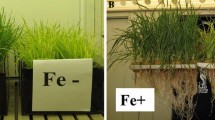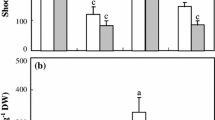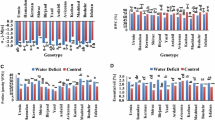Abstract
Iron stress responses were examined for 3 barley cultivars (Hordeum vulgare L. cvs. Steptoe, Morex and Dicktoo) grown at 5 iron levels (pFe 16.5, 17, 17.5, 18, 19) in chelator-buffered hydroponic solutions. Among the 3 cultivars, Steptoe produced the highest biomass and maintained the highest leaf chlorophyll content at each incremental decrease in Fe supply, followed by Dicktoo and Morex. All 3 cultivars responded to Fe limitation by early release of phytosiderophore prior to onset of Fe-deficiency chlorosis sp., but differed in the length of time prior to maximum phytosiderophore release. With Steptoe, near maximum release [42 μmol g−1 root (2 h)−1] occurred at day 6 for plants grown at pFe 18, and the plants maintained the same relative growth rate as Fe-sufficient plants (pFe 16.5) until day 15. In contrast, maximum rates of phytosiderophore release in Dicktoo and Morex peaked higher at 67 and 56 μmol g−1 root (2 hr)−1, but not until day 12 and day 18, respectively. By day 10, both Dicktoo and Morex were chlorotic and had a ∼50% decrease in relative growth rate. Under moderate Fe stress, all 3 cultivars decreased their shoot:root ratios by 25–30%, but differed with respect to specific root length and numbers of root tips per unit root length. The results suggest that differences in plant adaptation to Fe limitation cannot always be attributed to differences in quantities of phytosiderophore release, but also reflect several additive responses including timing of phytosiderophore release, root morphological adaptations and efficiency in Fe metabolism at low tissue Fe concentrations.
Similar content being viewed by others
References
Bell P F, Chaney R L and Angle J 1991 Free metal activity and total metal concentrations as indices of metal availability to barley (Hordeum vulgare). Plant Soil 130, 51-62.
Chaney R L, Bell P F and Coulombe B A 1989 Screening strategies for improved nutrient uptake and use by plants. Hort. Sci. 24, 565-572.
Clark RB, Römheld V and Marschner H 1988 Iron uptake and phytosiderophore release by roots of sorghum genotypes. J. Plant Nutr. 11, 663-676.
Crowley D E and Gries D 1994 Modeling of iron availability in the plant rhizosphere. In Biochemistry of Metal Micronutrients in the IThizo sphere Eds. J A Manthey, D E Crowley and D G Luster. pp. 199-223. Lewis Publishers, Boca Raton, FL.
Gries D, Brunn 5, Crowley D E and Parker D R 1995 Phytosiderophore release in relation to metal micronutrient deficiencies in barley. Plant Soil 172, 299-308.
Hansen N C and Jolley V D 1995 Phytosiderophore release as a criterion for genotypic evaluation of iron efficiency in oat. J. Plant Nutr. 18, 455-465.
Kawai S, Takagi S and Sato Y 1988 Mugineic acid-family phytosiderophores in root-secretions of barley, corn and sorghum varieties. J. Plant Nutr. 11, 633-642.
Lytle C M, Jolley V D and Brown J C 1991 Iron-efficient and ironinefficient oats respond differently to iron deficiency stress. Plant Soil 130, 165-172.
Marschner H 1998 Role of root growth, arbuscular mycorrhiza and root exudates for the efficiency in nutrient acquisition. Field Crops Res. 56, 203-207.
Mori S 1994 Mechanisms of iron acquisition by Graminaceous (strategy II) plants. In Biochemistry of Metal Micronutrients in the Rhizosphere. Eds. J AManthey, D E Crowley and D G Luster. pp. 225-249. Lewis Publishers. Boca Raton, FL.
Neumann G and Römheld V 2001 The release of root exudates as affected by the plant's physiological status. In The Rhizosphere: Biochemistry and Organic Substances at the Soil-Plant Interface. Eds. R Pinton, Z Varanini and P Nannipieri. pp. 41-94. Marcel Dekker, Inc., New York.
Parker D R, Norvell WA and Chaney R L 1995 GEOCHEM-PC, A chemical speciation program for IBM and compatible personal computers. In Soil Chemical Equilibrium and Reaction Models. Vol. Spec. Pub. No. 42. Eds. R H Loeppert, A P Schwab and S Goldberg. pp. 253-269. Soil Sci. Soc. Am. Madison, WI.
Römheld V and Marschner H 1990 Genotypical differences among graminaceous species in release of phytosiderophores and uptake of iron phytosiderophores. Plant Soil 123, 147-153.
Ruiz J M, Baghour M and Romero L 2000 Efficiency of the different genotypes of tomato in relation to foliar content of Fe and the response of some bioindicators J. Plant Nutr. 23, 1777-1786.
Sah R N and Miller R O 1992 Spontaneous reaction for acid dissolution of biological tissues in closed vessels. Anal. Chem. 64, 230-233.
Takagi S 1976 Naturally occurring iron-chelating compounds in oatand rice-root washing. I. Activity measurements and preliminary characterization. Soil Sci. Plant Nutr. 22, 423-433.
Tinker N A, Mather D E, Rossnagel B G, Kasha K J, Kleinhofs A, Hayes P M, Falk D E, Ferguson T, Shugar L P, Legge W G, Irvine R B, Choo T M, Briggs K G, Ulirich S E, Franckowiak J D, Blake T K, Graf R J, Dofing S M, MaroffM A S, Scoles G J, Hoffman D, Dahieen L S, Kilian A, Chen F, Biyashev R M, Kudma D A and Steffenson B J 1996 Regions of the genome that affect agronomic performance in two-row barley Crop Sci 36, 1053-1062.
Von Wiren N, Khodr H and Hider R C 2000 Hydroxylated phytosiderophore species possess an enhanced chelate stability and affinity for iron(III) Plant Physiol. 124, 1149-1157.
Williams E P, Clark R B, Ross W M, Herron G M and Witt M D 1987 Variability and correlation of iron-deficiency symptoms in a sorghum population evaluated in the field and growth chamber. Plant Soil 99, 127-137.
Author information
Authors and Affiliations
Corresponding author
Rights and permissions
About this article
Cite this article
Crowley, D.E., Wu, C.L., Gries, D. et al. Quantitative traits associated with adaptation of three barley (Hordeum vulgare L) cultivars to suboptimal iron supply. Plant and Soil 241, 57–65 (2002). https://doi.org/10.1023/A:1016047101677
Issue Date:
DOI: https://doi.org/10.1023/A:1016047101677




